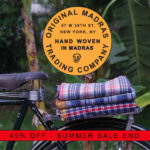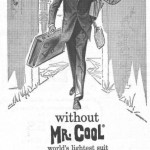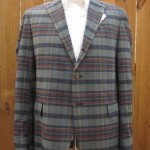 In honor of the mostly official start of summer, here’s my 2010 article on madras for The Rake.
In honor of the mostly official start of summer, here’s my 2010 article on madras for The Rake.
* * *
American Indian: Madras, named for the Indian city where it originated, remains a distinctly yankee summer staple
By Christian Chensvold
The Rake, issue 10
Though Brooks Brothers and Chipp were just across the street from each other — at 44th Street and Madison Avenue in New York City — their customer base was miles apart. That’s why one summer evening in the early ‘60s, Chipp employees moved dozens of unsold patch-madras sportcoats from one side of street to the other, changed the labels from Brooks to Chipp, and started ringing up sales the next day.
It’s one of Paul Winston’s favorite stories. Fresh from college, he had just joined his father’s legendary company Chipp, purveyors of the Ivy League Look but with a predilection for experimentation and whimsy — like Kama-Sutra linings in sober grey-flannel suits. This creativity also gave birth to the patching of madras, that comfortable, inexpensive and quintessential summer fabric. The fateful “Late-Night Madras on Madison Merchandise Swap” consisted of sportcoats from a third party used by both Chipp and Brooks Brothers. “We couldn’t get patch-madras sportcoats in fast enough, and Brooks couldn’t sell them,” Winston remembers. “Relatively speaking, we were considered edgy, and they had old-line, conservative blue-blood customers who looked down on it.”
The passing of time makes fertile ground for irony. Brooks Brothers has all but declared 2010 the year of madras, offering dozens of products in categories from shirts and shorts to sportcoats, ties, pocket squares and even loungewear. And guess what? Patched items are the best sellers.
“It is an interesting year in terms of madras,” says Jeff Blee, divisional merchandise manager of men’s furnishings for Brooks Brothers. “We made a much more sizable investment in it this year. It fits the two ends of the fashion spectrum: It can be very subdued and traditional in a Nantucket way with blues and reds, but can also be a good vehicle for what I like to call Palm Beach Prep, which is a little more over-the-top in terms of color, with pinks, greens and oranges.
“Madras ebbs and flows in popularity,” Blee continues, “but we always do it. And at this point in the cycle we’re doing it head to toe — not that we want people to wear it that way. It’s a cloth that just screams summer.”
And it screams it in Tamil. Madras is named for the Indian city where the light, textured cotton fabric was first loomed (Madras became known as Chennai in 1996, part of a continuous process of redubbing Indian cities with Anglicized names). Its origins go back to the early days of the British Empire, when locals created cotton plaids inspired by Scottish tartans.
Today madras, as they say in the fashion industry, is “having a moment” — a long moment that’s been building for several years. Atlantis Fabrics, a New York-based importer of Indian textiles, reports that wholesale madras sales have risen 20 percent in each of the past five years. And this moment, like all the others since Brooks Brothers introduced madras resort wear in 1920, is a largely American phenomenon. Though Brooks Brothers maintains stores in the UK and Continental Europe, when it comes to annual madras offerings, “They’re never as gung-ho about it as we are here,” says Blee. “But in Asia, it’s a whole different story: Madras is wildly popular in our Japanese stores.”
However, madras may be slowly returning to its British roots, one pair of patchwork shorts at a time, thanks to designers like Nottingham-based David Keyte, who launched the line Universal Works last year after 12 years at Paul Smith. “I’ve always loved madras check,” Keyte says. “Paul was buying it years ago, even before I ever saw it in a Ralph Lauren ad!” On a recent trip to India, Keyte was captivated by the brilliantly colored fabrics he saw. “The array of fantastic patchworks in India is amazing,” he says. “The hardest things is limiting yourself to just one or two choices.” The result of Keyte’s travels is a pair of patch-madras shorts in Universal Works current collection. And while Keyte admits Brits are generally less adventurous with their summer clothes than Americans, “the shorts seem to be flying out the stores.”
For every material object there is a purist who wants it a certain way — usually an archaic way no longer available. With madras, the most coveted type is “bleeding madras,” something all but extinct, according to Ethan Huber of O’Connell’s, purveyors of traditional American style in Buffalo, New York since 1959. “We haven’t seen bleeding madras in years and years,” he says. “The old hand-loomed bleeding stuff is just impossible to get, and the dyes today just aren’t the same.”
Good thing O’Connell’s is prone to hoarding — or overbuying. The store boasts some 900 pieces of deadstock bleeding madras dating from the ‘60s to the ‘90s. When trickled out into the store or on the website, they sell immediately. And while photographing the many one-offs for e-commerce purposes is tedious, says Huber, “I like to get them out there and see people get excited about them.”
Always an inexpensive fabric (O’Connell’s’ current colorfast madras costs $6 a yard), the traditional vegetable dyes would “bleed” into each other during washing. They’d also bleed into other garments: Get caught in a summer shower wearing a madras sportcoat and your white oxford underneath might just turn pink. Bleeding madras is also highly sensitive to sunlight, and will fade after a few afternoons on the golf course. “If I put a sportcoat on a mannequin in the window,” says Huber, “if it’s not out of there in a week, you’ll see that the fabric under the lapel is darker.”
Purists have come to prize the quickly developed, lived-in look of bleeding madras, perhaps at the encouraging of manufacturers. “Genuine Indian madras, guaranteed to bleed,” was an ubiquitous label sewn onto garments during the madras heyday, a fine example of marketing spin, and vice recast as virtue.












Nice post. However, it only served to remind me that the bleeding madras jacket you were wearing in the photo the other day was no longer in stock at O’Connells.
Your photo essay from The Rake made me smile. Although not true madras, I wore a mismatched “madras” suit, tie & belt today that Thom Browne did last year for BB. As to BB’s patchwork madras shorts, each year I look forward to its arrival and addition to my collection.
“O’Connells, purveyors of traditional American style in upstate New York since 1959”
Aw, go ahead and say it. O’Connels is not in Syracuse or Ithaca or Albany or Rochester.
O’Connells is in Buffalo. The largest city in the state outside NYC and about as far “upstate” – i.e., away from Manhattan – as its possible to go.
Yes, Buffalo has a terminally bad rep for its atrocious winters, acres upon acres of abandoned and rundown industrial buildings and perpetual recession/depression. It may be the rustiest or the large rust belt cities since Detroit at least boasts prosperous (until recently) suburban cities.
In the 1990s I went to Buffalo on business for a few days each year, mostly in the summer I admit, and always found the city, its environs and the residents pleasant: early modern era high rise buildings designed by revered architects, a neat bicycle museum, an impressive lakeside historic naval ships exhibit, authentic neighborhood joints for food and music, fun minor league baseball in the city and outdoor summer theater near the Niagara River.
And, oh, yes,there’s O’Connell’s (they use an apostrophe toward both ends of their name, Christian). And O’Connell’s is all the better for being such a surprising and impressive find where its least expected.
Visiting Buffalo should be a cautionary tale for smug folks from, say, Silicon Valley, Seattle or Austin. Because 100-120 years ago Buffalo was one the world’s premier high tech cities, powered by an abundance of inexpensive hydroelectricity that attracted people from around the world (my maternal grandparents migrated there from Virginia for several years in the “teens”) to work in its gleaming factories, banks and other businesses. But Buffalo peaked in the 1950s and eventually lost tens upon tens of thousands of its then-state of the art high tech, high skill, high paid jobs (electrical machinery, Bell aircraft, etc.) and now seems to rely on government jobs (SUNY Buffalo medical school and other state money, the (reportedly) most expensive city government per capita in the U.S…).
But there’s O’Connells. Seeming to thrive in its niche. Which it deserves.
Just noted I missed a lot of apostrophes in O’Connell’s myself. Buffalo gets no respect… 🙂
You missed an L too, but I won’t hold it against you.
Ralph has some actual bleeding madras this year, you might have mentioned that.
nice article; lousy pictures.
I cannot personally stand patch madras. They’re way too busy. The colors overwhelm themselves
But I’ve been wearing madras shorts 8 months of the year for the past two years. As casual summer wear, they’re the fav.
And I second Richard’s comment. The one with the waist view is ridiculous.
Bleeding madras is not the only madras out there today.
Regular madras that does not bleed , is color fast and comes in more color varieties that were just not possible in vegetable dyes.
I bought some regular madras plaids and patchworks at: https://store.fabrics-textiles.com, and these are all color fast, and make beautiful garments. Bleeding madras has its own appeal, but its not for everyone.
I’m surprised the Yale connection wasn’t introduced – the story goes that Elihu himself shipped crates of it to the new college that he had accumulated during his time in India and it was provided cheap or free to the students who took to wearing it…
Don’t be surprised: I’ve never heard that. Please share further in comment, or email me if you’d like to write it up for the site.
C.
“…created cotton plaids inspired by Scottish tartans.”
Of course.
In India, wearing madras is considered low class. It is mostly worn by laborers and used for making pajamas.
A few years ago, Town & Country ran an interesting article about the history of the fabric and wrote about the connection with Yale university: https://www.google.com/amp/s/www.townandcountrymag.com/style/fashion-trends/news/gmp1413/history-of-madras-plaid/
Our weather in Mid-Michigan has finally warmed enough for my usual (since boyhood except for the hard rock phase of my late teens and early 20s) chino shorts (mostly khaki) with seersucker, twill, madras, or knit polo shirts. Sebago dock-siders on the feet of course. I’m sure I look very funny to my t-shirted, camouflaged neighbors, probably like a space alien of some kind, but hey. . . By the way, the hair is nice a short once more with a side part as it should be. Did it myself with a Wahl clipper, and it turned out pretty well.
Best Regards,
Heinz-Ulrich
The facial expression of the fellow in madras is called Blue Steel.
Cheers
Will
The large number of patterns in almost all of the images leads to visual confusion. Far too many patterns leading to a stylistic clash.